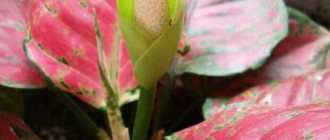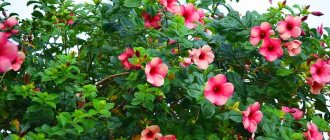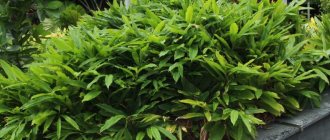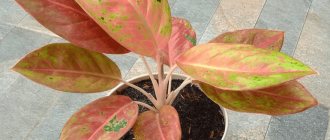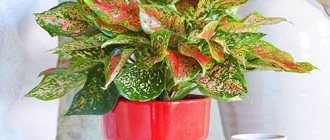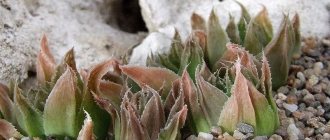Aglaonema is a houseplant belonging to the Araceae family, whose representatives also include Monstera, Anthurium, Dieffenbachia and others. The name Aglaonema comes from the merger of two Greek words, one of which means “magnificent, bright”, and the other translates as “thread, stamen”.
In its natural environment, aglaonema is found in the tropical rainforests of Southeast Asia.
Currently, aglaonema is not appreciated by flower growers. It takes root well even in unsuitable conditions and can survive with a lack of moisture and natural light. Aglaonema can be considered one of the most unpretentious house plants, the cultivation of which does not require special conditions.
[!] However, we should not forget that, like many representatives of the Araceae family, aglaonema is a plant containing a small amount of toxic substances. Always follow safety precautions when caring for Aglaonema. Place the flower out of reach of children and animals.
Aglaonema is a small plant, and the smaller it is, the better and more attractive it looks. Aglaonema has spear-shaped, gracefully hanging leaves that can reach 12-16 centimeters in length. They can only lose their appearance in severe winter cold or when the plant lacks nutrients.
Aglaonema also looks very beautiful in mixed plantings (as a companion for other plants). Its leaves contrast sharply and stand out from the rest.
What does aglaonema look like?
The flower's appearance resembles a small bush 0.25-1 m high with a short straight stem and tightly fitting long fleshy leaves. They can be different shades of green and, less often, red (depending on the variety), with white, pink, silver, yellow streaks and spots. The green pet blooms with small cobs, which are strewn with pale green, pink or white small rosettes. The fruits are ruby or orange oblong berries, sometimes white, with one seed inside, suitable for sowing.
Varieties of Aglaonema
Due to the height of the bushes, flower varieties are divided into three groups:
- Short. They have a size of up to 25 cm, creeping or drooping stems;
- Medium height. Their leaf blades grow up to 30 cm in length;
- Tall. They have a size of 1 m and leaves up to 40 cm.
The most famous types of aglaonema with photos:
- "Silver Queen" A flower up to 40 cm high that loves a lot of light, which gives it a special variegation. It has a beautiful silver-blue leaf surface;
- “Crete” (sometimes called red aglaonema) is a plant with brightly colored foliage with pinkish, green, and purple splashes. The variety requires bright lighting. Reaches 30-40 cm in height;
- "Maria". It is a medium-sized crop with dense emerald-colored leaves. This “green resident” is shade-tolerant; even a room with artificial light will suit it;
- "Modest." The bright green plant reaches a height of 50 cm, has pointed leaves, rounded with noticeable veins, which are elongated up to 20 cm;
- “Changable” (another name is “changeable”). It is an upright bush with elongated dark green glossy foliage in the shape of an ellipse, up to 30 cm long. A room with diffused light is well suited for favorable growth.
The best varieties of aglaonema with photos and names
Aglaonema King of Siam or King of Siam King of Siam
Aglaonema King of Siam King of Siam photo
The powerful petioles are quite tall, white, and hold dense dark green leathery leaves with expressive white veins. The bush is compact, densely leafy.
Aglaonema Maria Aglaonema Commutatum Maria
Aglaonema Maria Aglaonema Commutatum Maria photo
The Maria variety is loved due to the very beautiful coloring of the leaves: on a dark green background there are light spots-stripes in a symmetrical herringbone pattern in the direction of the veins. The leaves are elongated, the bush is compact.
Aglaonema Silver Queen Silver Queen
Aglaonema silver queen Silver Queen photo
The stunning colors of the Silver Queen variety, combined with the beautiful shape of the leaf, made the Silver Queen a real queen among all aglaonemas.
Aglaonema Silver Bay Aglaonema Silver Bay
Aglaonema Silver Bay Aglaonema Silver Bay photo
Almost white, with a silvery tint, with dark green outlining strokes along the edges, the leaves of this plant look mesmerizing. You just can’t take your eyes off the Silver Bay variety.
Red Aglaonema Crete Aglaonema Crete
Aglaonema Crete Aglaonema Crete photo
The Crete variety is notable for its rare shade of purplish-red outlining stripes along the edge of the leaf and rare veins. The leaves are elongated, pointed, slightly sinuous, bent inward in the center.
Aglaonema Stripes Aglaonema Stripes
Aglaonema Stripes Aglaonema Stripes photo
A playful striped pattern reminiscent of a zebra will add a fresh touch to any interior. The Stripes variety fits effectively into apartment and office settings.
Aglaonema Maria Christina Aglaonema Commutatum Maria Christina
Aglaonema Maria Christina Aglaonema Commutatum Maria Christina photo
The amazing bluish-silver hue with small dark green spots-stripes along the veins and along the edge of the leaf makes an indelible impression. The Maria Christina variety combines effectively in compositions with dark green and red decorative foliage plants.
Aglaonema Pink Aglaonema Pink
Aglaonema Pink Aglaonema Pink Ruby photo
Pink varieties (pink) are very interesting for their unusual color with small or large dark green spots. The drawings are very diverse, which opens up wide scope for imagination in creating compositions that decorate the interior.
Aglaonema Diamond Bay Aglaonema Diamond Bay
Aglaonema Diamond Bay Aglaonema Diamond Bay photo
The Diamond Bay variety has long, pointed leaves, slightly curled, and has a compact, densely leafy crown. The coloring is also original: dark green around the edges, in the center the leaves have a greenish-silver tint.
Aglaonema AnYaManee
Aglaonema anyamanee photo
The pink variety AnYaManee has earned itself particular popularity, having colorful shades of pink and green with a fancy marble pattern. The leaves are leathery, dense, with a slight gloss.
Aglaonema Sab Mongol
Aglaonema sab Mongol photo
Luxurious leaves with a velvety pattern in rich burgundy and green shades simply captivate the eye. The Sab Mongol variety will decorate any interior, introducing elements of luxury.
Aglaonema Green Lady Aglaonema Green Lady
Aglaonema Green Lady Aglaonema Green Lady photo
The Green Lady variety Aglaonema Green Lady is very impressive thanks to the beautiful shape of the leaves with pointed tips and variegated color, mixing rich green and light green with a silver tint.
Aglaonema Cutlass Aglaonema Cutlass
Aglaonema Cutlass Aglaonema Cutlass photo
A special feature of the Cutlass variety Aglaonema Cutlass is its long narrow leaves, collected in a dense basal rosette, reminiscent of the top of a palm tree. Delicate light green, almost silvery color, set off by dark green veins and edges along the edges of the leaves.
Planting and growing a flower
It is not recommended to immediately replant a houseplant aglaonema purchased in a store. Let it adapt within 2-3 weeks.
Landing rules:
- Place drainage in the pot - expanded clay, small pebbles, broken shards or nut shells;
- Fill the soil up to 1/2 volume;
- Place the flower in the center of the pot, straighten the roots, add substrate;
- If the plant is young, then there is no need to deepen it, but an adult plant can be planted a little;
- Generously water the crop with warm water.
What can be done to make the flower grow lush and beautiful? You need to know its features:
- The tropical bush loves places with diffused light, as well as slightly shaded ones. Protect it from direct sunlight and do not place it near heating appliances;
- In summer, the temperature should be + 20-25 degrees, in winter – slightly lower;
- The flower prefers warmth and high humidity, so water it twice a week, and especially take this into account in dry weather;
- The culture does not tolerate drafts and does not like to come into contact with tobacco and other smoke.
Pests and care problems
Aglaonema leaves turn yellow, what to do photo
Aglaonema can be affected by spider mites, mealyworms, aphids, whiteflies, and thrips. When they appear, treatment with insecticides is necessary.
If aglaonema leaves turn yellow, there is one of the problems:
- The plant was overdried, the roots were damaged and the flower died. Urgent cuttings from the tops are required. The cuttings are kept in the root and planted in moist soil under a transparent cover.
- The flower is cramped in the pot, all the nutrients from the soil have already been used and it requires replanting into a larger pot, replacing the soil and fertilizing two weeks after replanting.
The plant is not susceptible to disease, but due to errors in care, certain difficulties may arise.
- The leaves wrinkle and the tips turn brown from the dry air.
- Leaves curl from drafts.
- Yellow spots appear from sunburn.
- Plant growth slows down and the leaves turn brown at the edges. The cause is cold or hard water. You can reduce water hardness with citric acid: 1-2 g. per liter of water.
Soil and pot for the plant
In order for a flower to grow healthy and attractive, it is necessary to have nutritious soil. The soil should have good water and air permeability and be loose. If you prepare the soil yourself, then in composition it should consist of: three parts of leaf soil, one part of peat, one part of sand, as well as 1/2 part of charcoal and 1/2 part of humus. You can buy ready-made soil for heather, azaleas or violets. This composition is perfect for our “green friend”.
The root system of the plant is fibrous and superficial, so it does not need a deep pot. An indoor flower has excellent leaf growth and better development is possible if its roots grow in a small container. The ideal option would be a wide (if there are young shoots) and shallow pot, but do not forget that 1/4 of its height must be filled with drainage.
Features of cultivation
Home care for different varieties of aglaonema is the same. The main principle is to grow the plant indoors. Of course, this is an optional condition, but if you decide to move the aglaonema outdoors, you need to create a special atmosphere for it.
- Container and soil. It is recommended to plant a young plant in a container with a diameter of no more than 15 cm. After this, the pot is placed in an even larger container containing a mixture of moss and peat. For this soil, constant moisture is maintained. In the spring, aglaonema is assigned to a permanent place.
- Illumination. These plants tolerate changes in light neutrally, so most often they are placed in a well-lit place. This slightly stimulates the growth of the plant, although it does not significantly affect the process.
- Temperature and humidity. The plant can withstand a decrease in heat levels to +10 degrees, but a prerequisite for the growth and development of the flower is high humidity. The optimal temperature is 14-16 degrees Celsius with moderate humidity. In summer - 20-24 degrees above zero with high humidity.
- Water the plant twice a week. In winter, the irrigation process needs to be carried out less frequently.
In the absence of the required level of humidity, it is necessary to moisten the leaves of the plant from a spray bottle.
How to care for aglaonema
Caring for aglaonema at home involves regular watering, fertilizing, spraying and timely replanting. To maintain air humidity at the desired level around the pot, it can be placed in a tray with wet pebbles or expanded clay. The leaves of the plant must be frequently wiped or watered from the shower. Then they will not lose their shine and brightness. Let's look at the description of the rules of care in more detail.
Watering aglaonema
Abundant watering of the plant must be done from April to November, when the top layer of soil dries out. But moisture should not be allowed to remain in the root system for a long time. The frequency and abundance of watering is selected based on the temperature of the room - when it is cool, the flower requires less water.
In winter, the amount of moisture is reduced by watering two days after the soil has dried. In summer, it is necessary to water the bush every other day.
Pruning aglaonema
In order for a flower to become bushy, you need to prevent it from blooming and cut off growing shoots with buds. This will lead to the appearance of new buds, and the bush will begin to grow, acquire splendor and beauty.
If during growth the stems become bare and the shoot seems bald, then the top of the trunk on which the voids have appeared is cut off. Soon after this, young leaves and shoots will begin to grow at the cut site. And the cut cuttings can be placed in water or in soil covered with film. After some time it will begin to take root.
Care
When growing the codiaum variegum plant, care at home will require fulfilling a number of requirements.
Lighting
All forms and varieties of “Joseph's cloak” need bright, mostly diffused, lighting.
Windows facing west or east are considered the best for codiaums.
On the southern windows, shading is necessary - otherwise there will be burns, and on the northern windows - additional lighting so that the motley color does not disappear.
Temperature
Croton needs a warm habitat, without drafts and sudden transitions from heat to cold, with an even annual temperature variation.
Optimal ranges are 20-22 degrees in summer and 18-20 degrees in winter.
In any case, the temperature should not drop below 16 degrees. In cold soil the plant rots.
The soil
“Joseph's Cloak” feels good in loose, fertile soil with a neutral or slightly acidic reaction.
Ready-made soil mixtures are suitable for palms and ficus.
You can also mix equal amounts of turf, leaf (or peat) soil and washed river sand.
A few more recipes suitable for croton:
- Garden soil, peat and sand in a ratio of 3:1:1;
- Turf soil with small amounts of sphagnum and sand;
- Turf, leaf soil and sand in a ratio of 2:1:1.
Before filling the planting container with soil substrate, a drainage layer of expanded clay, broken bricks and pieces of charcoal must be poured onto its bottom in order to prevent stagnation of water and rotting of the root system.
Transfer
When replanting a grown plant, choose a slightly larger pot, 2-3 cm larger in diameter than the previous one.
Croton will not like an overly spacious “apartment”.
When replanting variegated croton, they try to transfer it without destroying the earthen ball.
The frequency of transplants depends on the age of the croton and the intensity of its growth.
As a rule, young specimens require an annual change of “home”.
With age, the interval between transplants will be 2-3 years or more.
It is recommended to replant codiaum purchased in a store into a “home” container with a drainage layer and fresh soil mixture, freeing its roots from the transport substrate.
Humidity
Croton is a true child of the tropics and needs year-round high air humidity: ideally it should be 70-80%.
Such a plant must be sprayed with soft water - regularly, daily, especially since it has practically no rest period.
A monthly shower is also useful, as is placing the container on a tray with wet pebbles.
Watering
For regular, abundant watering of the “Joseph’s cloak,” you need soft, well-settled, not cold water.
When dosing, it is important to follow the principle: “water, but do not overfill.” Ideally, the soil does not dry out more than 2 cm, and water does not stagnate in the pan
Ideally, the soil does not dry out more than 2 cm, and water does not stagnate in the pan.
Those gardeners who understand the language of plants well focus on the barely noticeable drooping of the codiaum leaves: as soon as this occurs, watering is needed, and quite generously.
Top dressing
From April to August, croton should receive weekly fertilizing with fertilizers for variegated or decorative deciduous plants. Alternating organic and mineral fertilizing also gives good results.
In the autumn-winter period, the frequency of fertilizing (after watering, on wet soil) is reduced to once a month.
Bloom
In the summer, under favorable conditions, crotons can bloom with inconspicuous shaggy bunches of balls.
Flowering, pollination, and ripening of codiaum seeds are a subject of interest to breeders who develop new varieties.
In the usual practice of home floriculture, the resulting buds are removed so that the codiaum does not waste energy on the development of flowers.
The very intention of the croton to bloom indicates that the plant is happy, it wants to live and reproduce here.
Reproduction
In indoor culture, codiaum is propagated vegetatively: by cuttings and layering.
Propagation by cuttings: The best are apical cuttings 10-15 cm long, with at least two pairs of leaves, cut with a sharp knife in January-April.
The cut areas are sprinkled with crushed charcoal. The milky juice is washed off, the lower cut of the cutting is treated with a root formation stimulator and placed in soil with a temperature of 25-26 degrees.
Popular articles Pruning geraniums for the winter: step-by-step instructions, basic rules, further care
Cover with plastic wrap, ventilate regularly, moisten the substrate, and spray the cuttings.
The standard rooting period is a month.
Reproduction by air layering: With this method of propagation, a fairly long branch is selected, bent to the surface of the soil, sprinkled with it and fixed.
After the buried branch takes root and produces new shoots, it is separated from the original plant.
Reproduction of aglaonema
This plant can be propagated in three ways:
- Dividing the bush;
- By cuttings;
- Seeds.
The first method is the easiest to implement. During the April or May transplantation, strong, healthy shoots with 3-4 leaves and roots are carefully plucked from the bush. In this case, the part that should be underground is carefully cut with a sharp knife. The daughter shoot is planted for rooting in a separate container with fertile soil. With regular watering and fertilization, it begins to grow vigorously.
The second method - cuttings, involves cutting the stem with the apical part and dividing the trunk into several more segments of 9-12 cm, each of which should have leaves. The cuttings are dried for a couple of days, the sections are covered with charcoal. Next comes the rooting stage:
- The cuttings are planted to a depth of 5 cm in a mixture of sand and peat;
- Rooting must be done at a temperature of +22-25 degrees. This will help the roots form faster within a month;
- By providing the flower with heating from below, rooting can be carried out at any time of the year. Otherwise, it is better to wait for warm summer time;
- After strengthening the bush, it can be moved to a separate container filled with soil for young plants.
Reproduction by seeds, which emerge from red fruits, is carried out in the summer. It is not worth storing seed material, because it quickly deteriorates and loses its viability.
- Aglaonema seeds are washed and immediately sown in cups with a sand-peat substrate;
- They need to be constantly watered and kept in a warm place;
- Shoots appear quite quickly. When forming leaves, you need to plant the flowers in separate pots;
- Full development of plants occurs after 3-4 years, but varietal characteristics are not always preserved.
You can buy an already mature aglaonema flower in flower shops or in specialized online stores. The cost varies significantly depending on the type. It starts from about 600 rubles and can reach up to 6,000 rubles. You can also purchase the plant from amateur florists, where the price will be significantly lower.
Such a bright tropical bush can serve as a decoration for any home, and its main advantage is its unpretentiousness, which is highly valued by floriculture lovers.
Description
Aglaonema is not a very common plant. The tropical plant is loved for its beautiful foliage. The shade and shape may vary depending on the variety.
Culture has useful qualities:
- kills streptococcal infection;
- cleans the air well;
- reduces benzene content.
In general, there are more than 50 varieties of this plant. They are usually classified by height into:
- tall;
- average;
- short.
Many of the varieties adapt well to apartment conditions. There are shade-tolerant species. But, if small children live in the house, then you should avoid growing this plant, since its juice is poisonous.
The leaves of the plant are usually oblong, about 10-15 cm in length. Their color varies from pure green to decorated with spots or stripes of different shades. A rare culture is blooming, and there is no special beauty in it.
